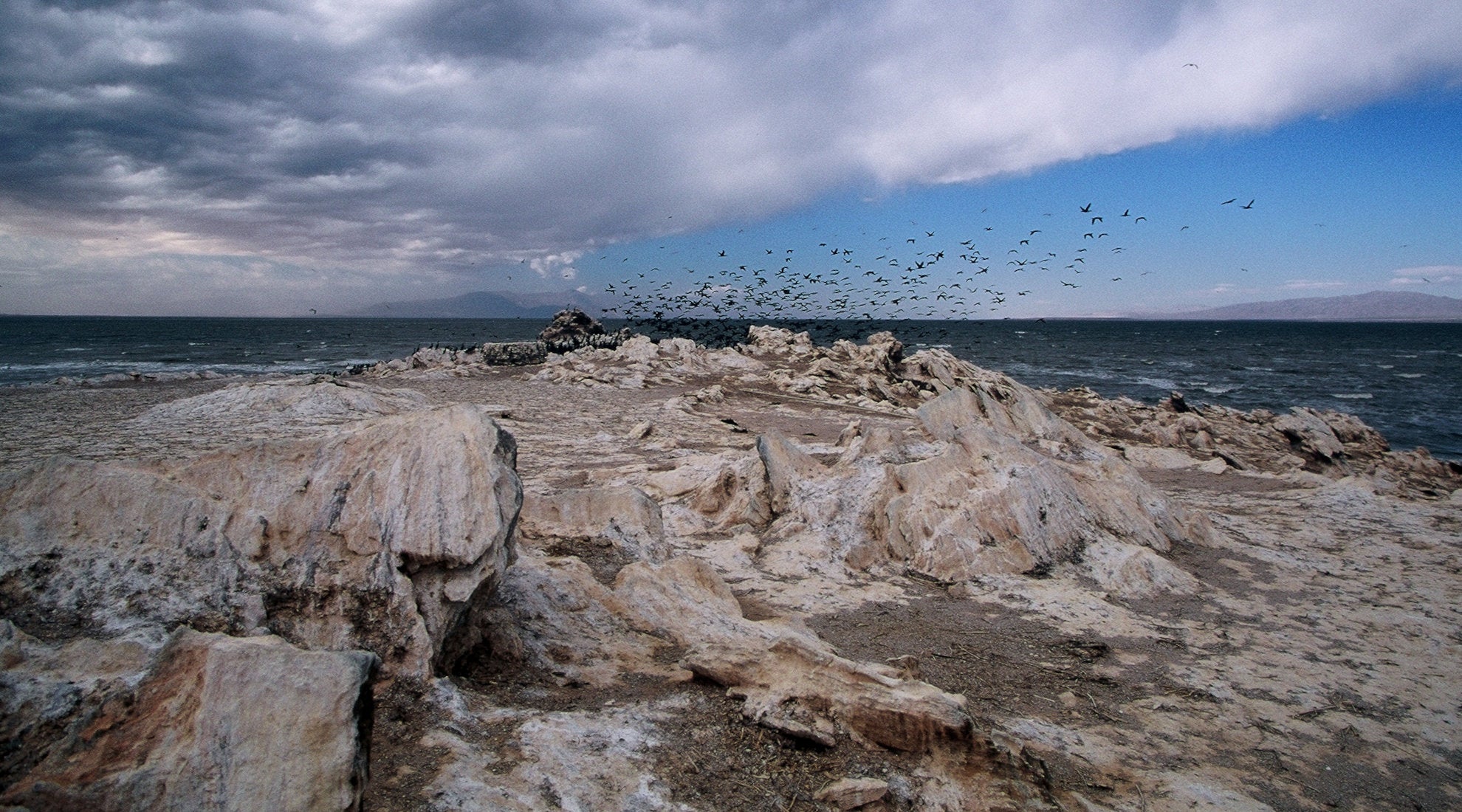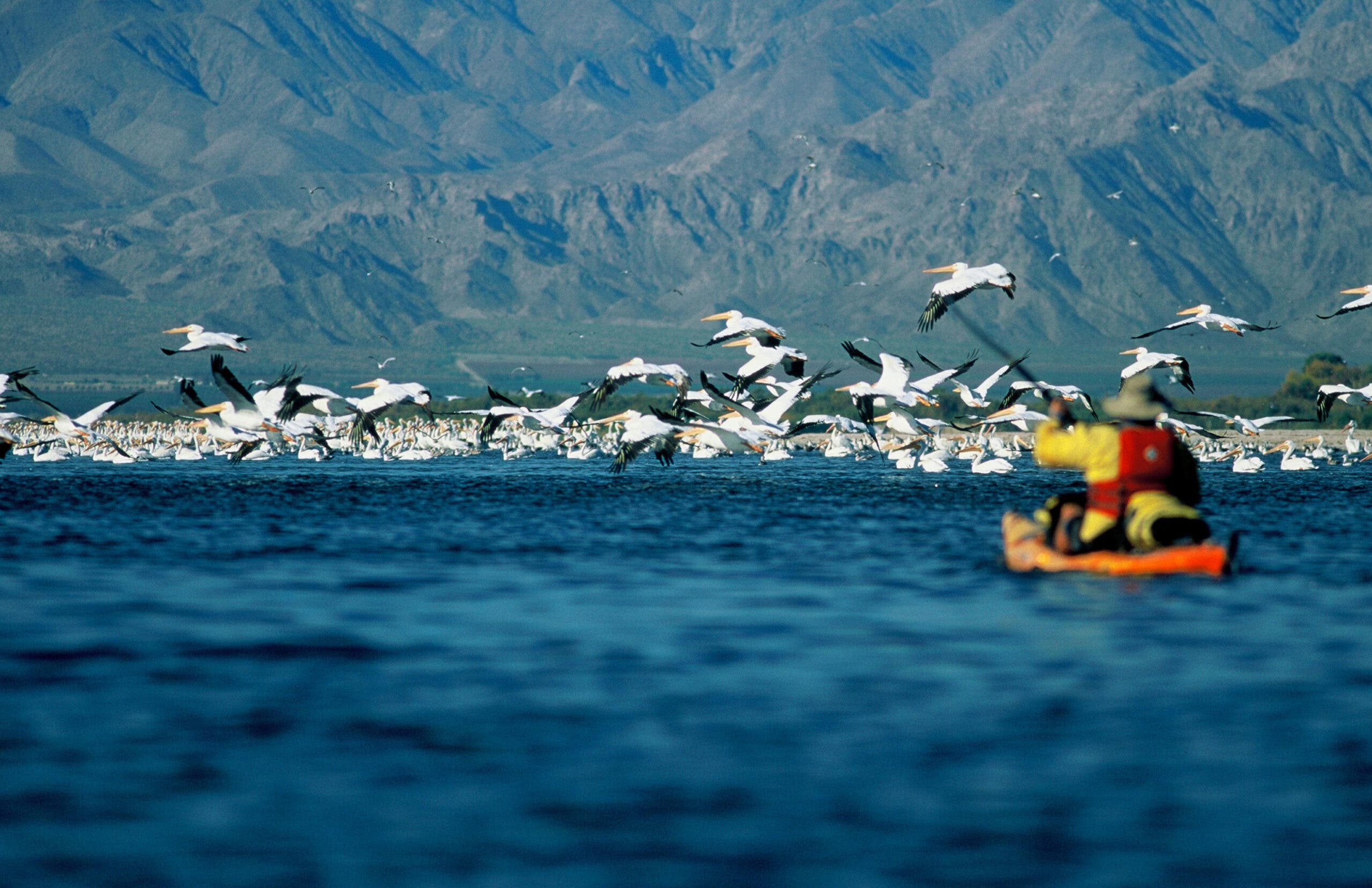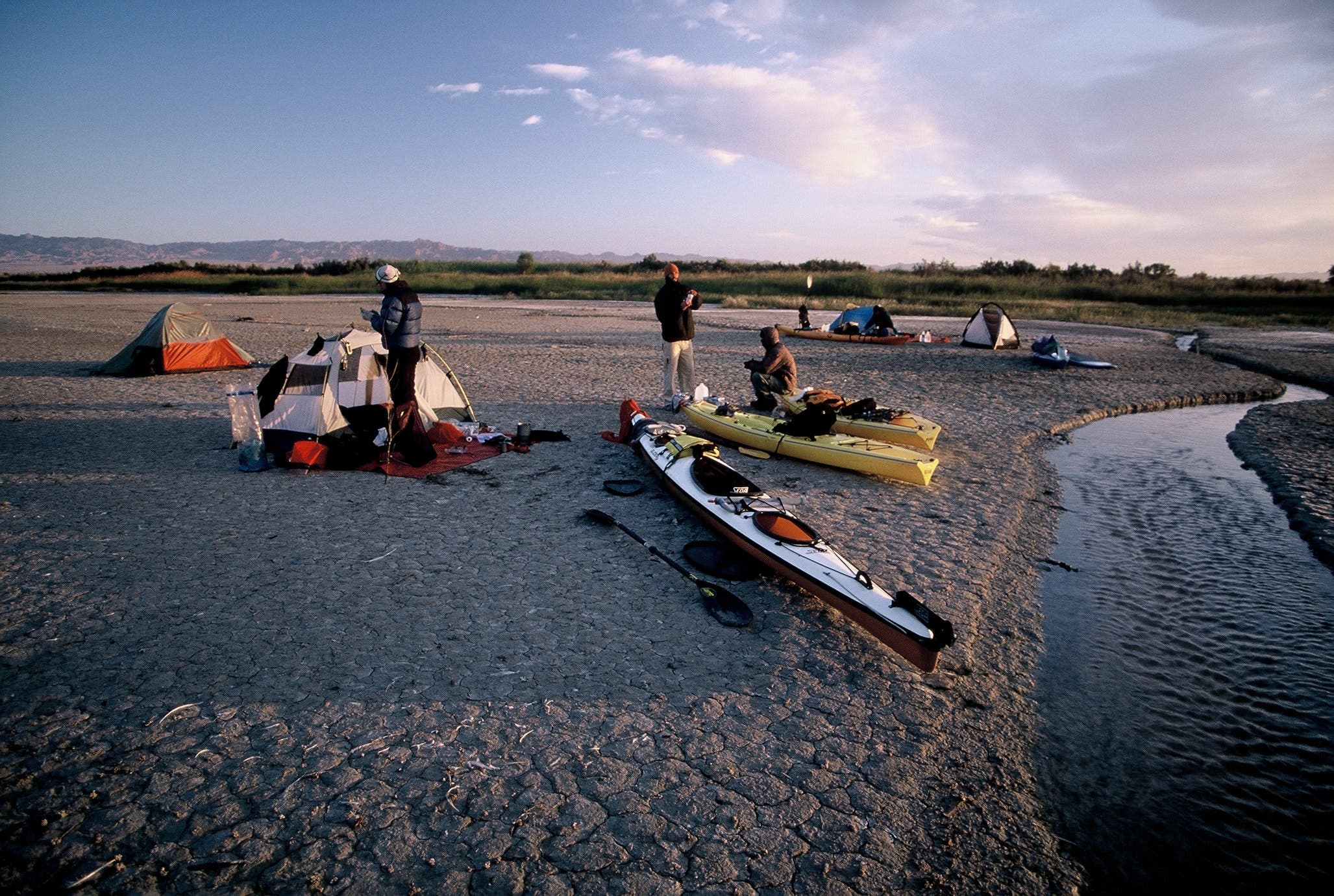The Salton Sea Is an Environmental Disaster—and it's Also Gorgeous

The Salton Sea is home to more than 400 species of birds. (Photo: Chuck Graham)
Before I even stepped out of my tent, I knew it was going to be a crowded morning on the Salton Sea. The distant desert horizon was a palette of streaking pinks and purples. The only disturbance on the water was hundreds of migratory American white pelicans busily bathing in the silky-smooth waters of California’s largest lake.
The man-made Salton Sea is a haven for birdlife in the Colorado Desert of southeast California. It’s also a unique paddling destination with rolling, windswept sand dunes, defunct harbors, and marinas choked off by seemingly impenetrable sandbars, geological relics, and a ghostly military outpost. Located between Joshua Tree National Park and Anza Borrego Desert State Park, the Salton Sea is a unique slice of the desert.
As my friends Patrick O’Hea and Will Miller readied their standup paddleboards for our four-day trip around the inland sea, I tinkered with my kayaking gear along the crunchy, briny shoreline.
No matter how much time you’ve logged on the water, the Salton Sea is different. Lengthy stretches of the sea’s 110 coastal miles are not accessible on foot or by car, so paddling allows adventurers to explore all those desert nooks and crannies. The water itself is 25 percent saltier than the Pacific Ocean, so each stroke propels you even further when conditions are glassy. Even after five paddling trips on the Salton Sea, the curiosity it inspires in me has never waned.
Ebb and Flow
I had heard the Salton Sea was dead, a desert wasteland of yesteryear when it once held the reputation of being “the next Las Vegas.” Its resort-like atmosphere breathed life into this man-made lake from the 1940s to 1960s.
Until the Colorado River flooded in 1905 and again in 1907, the Salton Sea was known as the Salton Sink: a deep, dry depression 269 feet below sea level. Located between the Coachella and Imperial valleys, it was one of the lowest points in North America before flooding, second only to Badwater Basin in Death Valley at 282 feet.
By the early 1940s, the Salton Sea had evolved into a raucous weekender’s paradise abuzz with fishing tournaments, water ski jumps, and boat races. Hollywood also took notice, with celebs such as the Marx Brothers, Frank Sinatra, and Jerry Lewis frequenting the inland sea.

However, over the years flooding continued, stymieing further development. Then in 1970 those waters began to recede as farmers, whose runoff had fed the lake, began to use water more efficiently.. The lake has no outlet, and while there are two rivers, the Alamo and the New, that drain into the Salton Sea from the south, they are not enough to fill the entire body of water. Slowly but steadily, the lake began to dry up.
The combination of receding waters and the Salton Sea’s high salinity (concentrated as the lake continues to dry) have caused mass die-offs of fish; at this point, few species besides tilapia are able to withstand such high salt content 228 feet below sea level. Still, the birds love it, with over 400 species either residing year-round or migrating here for the winter.
Summertime is rough on the Salton Sea and its hardy residents. Temps hover above 100 degrees, and afternoon winds kick up dust devils and choking clouds of sediment. County, state, and federal agencies have known for years that the Salton Sea needs an environmental facelift. However, bureaucracy at all levels has thwarted any solutions to this slow-moving environmental catastrophe.
Geological Wonders
Guano-covered Mullet Island loomed on the horizon. Geothermal plumes wafted skyward from dozens of nearby mudpots, leaving a post-apocalyptic aura hanging over the craggy landscape. O’Hea, Miller, and I were paddling toward the convergence of the Salton Sea and the north-flowing Alamo River just southeast of a stretch of glistening mudflats.
As we paddled closer, a squadron of double-crested cormorants flew just above the surface of the smooth waters. A massive flock of pelicans and a band of California gulls soon joined the skittish seabirds. Soon, hundreds of wings hummed in unison over Mullet Island.
After pitching our tents at the mouth of the Alamo River, we paddled back to Mullet Island. The whole thing was barren and slathered in seabird guano: Double-crested cormorants nest on the extinct volcano each year, so the isle is pearly white. The Salton Sea lies on the San Andreas Fault, and from the island, we could glimpse several other extinct volcanoes along the southeast shoreline.

Warm mud oozed between our toes as we stepped on the extensive mudflats behind the island. The open mud pots were another 200 yards from shore; an old, faded sign warned visitors to stay back. Geothermal activity is prevalent throughout the southeast region of the Salton Sea, and the plumes of steam are visible from miles away.
The sun was setting as we headed back to our tents. Twilight is a magical time on the Salton Sea. Pink and orange hues swept across the Santa Rosa Mountains to the west and the Chocolate Mountains to the northeast. It was another tranquil moment in the desert of southeastern California.
Guns Blazing and Old Navy
Not all the curiosities of the Salton Sea are natural. During another mid-winter paddling trip on the Salton Sea, my longtime paddling buddies Danny Trudeau, Dave Glaser, and brothers Kyle and Erik Denitz, and I launched late afternoon from the Salt Creek Kayak Camp on the lake’s north shore. The paddling conditions were stellar: Wispy clouds hovered above a lake teeming with American avocets, western sandpipers, resident, centurion-like herons, and egrets. As sunset approached, I found a solid enough mudflat for us to camp on for the night.
As dusk melted into a brilliant starry night, the birds kept singing. At about 4 a.m., however, we awoke to a steady barrage of gunfire resonating across the sea. We had failed to realize that it was duck hunting season on the Sonny Bono National Wildlife Refuge. Fearful of leaving our tents, we laid low, hunkering down to avoid any stray shot. Four hours later, after the gunfire ceased, we quickly broke down our tents, loaded our gear and paddled toward the south side of the lake.
Twelve miles later, we landed our kayaks along the briny shoreline beneath wind-groomed sand dunes. We pitched our tents and paddled a few miles south to the abandoned Salton Sea Test Base. The U.S. government opened the base in 1942 as a training ground for naval aviators and a lab for researchers testing rocket and jet technology; in 1944 and 1945, the pilots of the B-29s that would later drop the atomic bombs on Japan used the area for target practice. But the base hadn’t been active since the first Desert Storm in 1991, and now salt crust and seabird guano cloaked the site, lending it a ghostly appearance.
After paddling between splintered pilings topped with watchful cormorants, we carefully walked the long, decrepit dock. Broken glass and bullet casings littered its entire length; the shifting sand dunes were reclaiming other sheds and outbuildings. A lone coyote yelped at us as it scavenged along the shoreline, the sun dipping behind the Santa Rosa Mountains in the distance.
The next morning, we awoke to a breathtaking desert sunrise and a sea that was deserted except for a lone white pelican. We had a good 15-mile paddle ahead of us, and we wanted to beat the desert heat. Even leaving early, the temperatures were already in the low 80s, and we were soaked in sweat by the time we landed at the Salt Creek Camp on the northeast shore and its refreshing cold showers.
The five of us were also covered in salt, especially our kayaks. After four days paddling the Salton Sea, the inland lake had left its imprint on gear, and our minds too. I was already hatching a plan for my next trip across its waters.